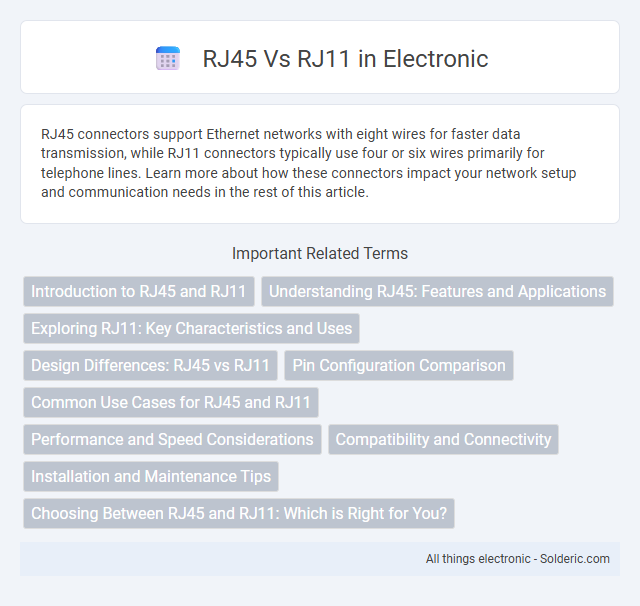RJ45 connectors support Ethernet networks with eight wires for faster data transmission, while RJ11 connectors typically use four or six wires primarily for telephone lines. Learn more about how these connectors impact your network setup and communication needs in the rest of this article.
Comparison Table
| Feature | RJ45 | RJ11 |
|---|---|---|
| Use | Ethernet Networking | Telephone Lines |
| Number of Pins | 8 | 4 or 6 |
| Connector Size | Larger | Smaller |
| Data Transmission | High-speed Ethernet (up to 10 Gbps) | Voice and low-speed data |
| Cable Type | Cat5, Cat5e, Cat6 cables | Telephone cords |
| Compatibility | Network devices, routers, switches | Telephones, modems |
| Pin Layout | 8P8C (8 positions, 8 contacts) | 6P4C or 6P6C |
Introduction to RJ45 and RJ11
RJ45 is an 8-pin connector primarily used for Ethernet networking, supporting higher data rates and faster communication in local area networks (LANs). RJ11 is a 6-pin connector designed mainly for telephone lines, facilitating voice communication and low-speed data transmission. Both connectors differ significantly in pin configuration, size, and application, making them suitable for distinct purposes in telecommunications and networking.
Understanding RJ45: Features and Applications
RJ45 connectors feature eight pins and are primarily used for Ethernet networking, supporting high-speed data transmission in LAN environments. Designed to fit twisted-pair cables, RJ45 ensures reliable connections for devices such as computers, routers, and switches. Commonly employed in data communication and telecommunication systems, RJ45 enables efficient network infrastructure with faster and more stable connectivity compared to RJ11.
Exploring RJ11: Key Characteristics and Uses
RJ11 connectors, commonly used for telephone wiring, feature 4 or 6 positions but typically utilize only 2 or 4 conductors, supporting voice and low-speed data transmission. RJ11 cables are narrower and less robust compared to RJ45, making them ideal for analog phone lines rather than high-speed networking. Their primary applications include single-line telephones, fax machines, and DSL internet connections, where simple connectivity is sufficient.
Design Differences: RJ45 vs RJ11
RJ45 connectors feature eight pins and are designed for Ethernet networking, allowing for faster data transmission and supporting Gigabit speeds. RJ11 connectors have four or six pins and are primarily used for telephone lines, limiting data capacity and transmission speeds. The larger size and pin count of RJ45 enable more complex and robust network connections compared to the simpler, smaller RJ11 used in voice communication systems.
Pin Configuration Comparison
RJ45 connectors utilize eight pins arranged in a single row to support Ethernet networking, enabling high-speed data transmission through balanced twisted-pair cables. RJ11 connectors have six pins but commonly use only two or four for telephone line wiring, carrying lower bandwidth signals for voice communication. The distinct pin configuration and functionality of RJ45 versus RJ11 determine their specific use cases in networking and telephony.
Common Use Cases for RJ45 and RJ11
RJ45 connectors are predominantly used for Ethernet networking, connecting computers, routers, and switches in local area networks, supporting high-speed data transfers up to 10 Gbps. RJ11 connectors are mainly utilized for telephone lines and modems, providing reliable voice communication over standard phone wiring. Understanding your network and communication needs ensures you choose the right connector for optimal performance and compatibility.
Performance and Speed Considerations
RJ45 connectors support Ethernet standards up to 10 Gbps with Cat6a and Cat7 cables, enabling high-speed network performance ideal for modern data transmission needs. RJ11 connectors, designed primarily for telephone wiring, support much lower speeds and bandwidth, typically limited to voice signals and low-speed data such as ADSL. The larger RJ45 connectors with eight pins provide enhanced data integrity and reduced crosstalk compared to the four or six pins in RJ11, making RJ45 the superior choice for fast, reliable network connectivity.
Compatibility and Connectivity
RJ45 connectors feature eight pins designed for Ethernet cables, supporting higher data transfer rates and network connectivity, while RJ11 connectors have four or six pins meant for telephone lines with lower transmission capacity. RJ45 is compatible with Cat5e, Cat6, and Cat7 cables, ensuring robust compatibility with modern networking equipment, whereas RJ11 is typically used for analog telephone systems and DSL connections. Devices designed for RJ45 ports cannot accommodate RJ11 plugs due to size and pin configuration differences, limiting direct cross-compatibility between the two interfaces.
Installation and Maintenance Tips
RJ45 connectors require precise alignment during installation to ensure proper Ethernet cable termination, minimizing network signal loss and cross-talk. Use a quality cable tester to verify continuity and correct wiring pairs after crimping the RJ45 plug, which helps prevent connectivity issues. For RJ11, maintain proper insertion depth into telephone sockets and avoid excessive cable bending to prevent line degradation and frequent troubleshooting.
Choosing Between RJ45 and RJ11: Which is Right for You?
RJ45 connectors support Ethernet networks with eight pins, enabling faster data transmission and superior performance ideal for internet and LAN connections. RJ11, with four or six pins, is designed primarily for telephone lines and low-speed data. Choosing between RJ45 and RJ11 depends on your need for high-speed networking or basic telecommunication, making RJ45 the right choice for modern digital communication setups.
RJ45 vs RJ11 Infographic

 solderic.com
solderic.com